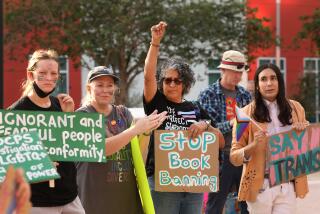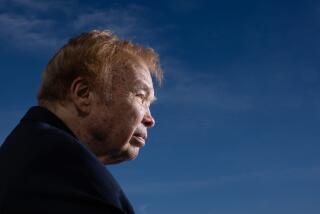Book review: ‘Clarence Darrow: Attorney for the Damned’ by John A. Farrell

Clarence Darrow: Attorney for the Damned
John A. Farrell
Doubleday: 400 pp., $32.50
For five stormy, pivotal decades, Clarence Darrow (1857-1938) was a towering figure in U.S. jurisprudence and politics. He served as defense lawyer for the people most hated and feared by respectable society and was indeed, as his friend Lincoln Steffens wrote in 1932, an “attorney for the damned.” At the turn of the 20th century when the government routinely threw its weight behind American industry as it crushed strikes and broke unions, Darrow was an unflinching supporter of organized labor, defending labor leaders charged with murder and terrorism.
He despised the death penalty. Confessed killers Nathan Leopold and Richard Loeb were the most notorious of those Darrow saved from the gallows with his emotional pleas for mercy. He was an open agnostic who made laughingstocks of William Jennings Bryan and fundamentalist Christianity in the raucous Scopes “monkey trial” of 1925. He advocated for women’s suffrage beginning in 1886 and for civil rights as early as 1899.
FOR THE RECORD:
Clarence Darrow book: A June 26 review of the book “Clarence Darrow: Attorney for the Damned” incorrectly identified its author, John Farrell, as James Farrell. —
But as John Farrell reminds us in his biography of a titanic American personality, Darrow was no left-wing saint. He was always in need of money and agreed to defend gangsters, bootleggers and crooked politicians for large fees. During his single term in the Illinois state legislature he fought for municipal control of streetcars and other utilities, then turned around and represented two Chicago streetcar companies as a lawyer. Although he was acquitted of bribing jurors during James B. and John J. McNamara’s trial for bombing the Los Angeles Times building in 1910, Farrell judges that Darrow was “almost assuredly” guilty — and that wouldn’t have been the first time.
Darrow would do whatever it took to save his clients. He cut a deal for the McNamara brothers to save their lives, though their guilty plea appalled the labor unions paying Darrow’s fee. The American Civil Liberties Union was unhappy about Darrow making a media circus out of the Scopes case, which the ACLU intended to be a dignified procession of appeals testing the principle of separation of church and state. “Darrow is hated by all Liberals as a renegade,” commented H.L. Mencken.
Radicals distrusted him as an opportunist. Darrow walked off the case of the “Scottsboro Boys,” charged with raping two white women in 1931, rather than follow the directives of their Communist Party-funded defense team. “The trouble with these fellows is that they think only of the cause,” he remarked. “No lawyer can accept this doctrine. The client, of course, always comes first.”
Yet Darrow had a cause and a faith, and Farrell’s sensitive, thematically rich narrative shows him remaining true to them both over the course of a tumultuous life. His cause was imperfect, troubled humanity. “We are all poor, blind creatures bound hand and foot by the invisible chains of heredity and environment, doing pretty much what we have to do in a barbarous and cruel world,” he declared. “That’s about all there is to any court case.” As a defense attorney, he aimed “to show the jury that the defendant is merely a man like themselves.”
His faith was that this barbarous world nonetheless “grinds down injustice and wrong and prejudice and hate, even though it is by the slow and cruel process of years.” Darrow did not expect the process to happen by itself or without resistance. “The powers of reaction and despotism never sleep,” he told the ACLU’s Roger Baldwin in 1929. Justice would come only from “constant agitating.”
Darrow’s brand of agitating, most evident in his famous closing arguments, took the form of placing his clients within the context of the social system prosecuting them. Defending labor leaders accused (often justifiably) of using violence, he reminded jurors that they were fighting against corporations whose brutal tactics and unconscionable working conditions had killed and maimed countless workers.
Speaking to members of an all-white jury in Detroit trying 11 black men who had allegedly wielded guns against a mob menacing their home, he asked, “Do you think that all the rights which you claim for yourselves are to be denied them?” Plenty of people thought exactly that in 1925, but by the time Darrow got through with jurors, they had almost always been persuaded to share, at least temporarily, the compassion that fueled his activism.
He died weeks before his 81st birthday in 1938, a gadfly to the last. “Funeral service?” said one childhood acquaintance. “I thought they’d just toss him off a cliff.” It would have been a fitting end for a man who took pleasure in outraging “the good people” whose opinion he disdained. In order to wrest from reluctant juries acknowledgment of their kinship with the social and political pariahs who were his preferred clients, Darrow employed bare-knuckle tactics, and even close friends sometimes suspected that he was motivated as much by love of publicity as by passion for justice.
Farrell’s clear-sighted, empathetic biography does not bother to dispute these charges or to tidy up Darrow’s character for a prettier portrait. He knows that he has a protagonist of Shakespearean richness and complexity, and this well-written, vividly atmospheric portrait captures Clarence Darrow with his faults and contradictions intact.
Smith is a contributing editor for the American Scholar and reviews books for The Times, the Washington Post and the Chicago Tribune.
More to Read
Sign up for our Book Club newsletter
Get the latest news, events and more from the Los Angeles Times Book Club, and help us get L.A. reading and talking.
You may occasionally receive promotional content from the Los Angeles Times.








